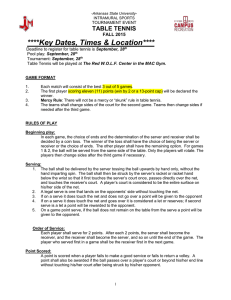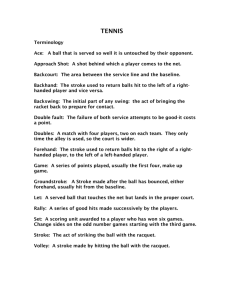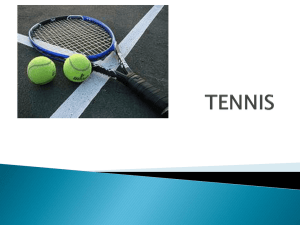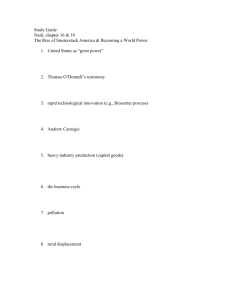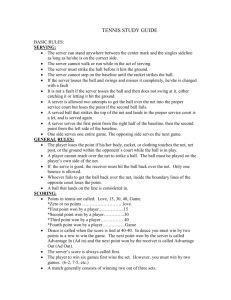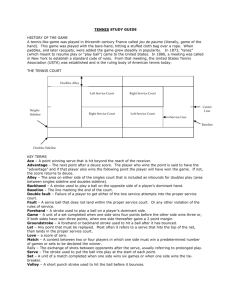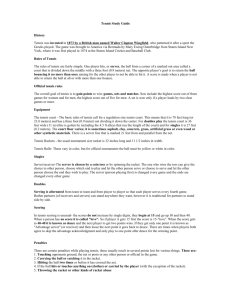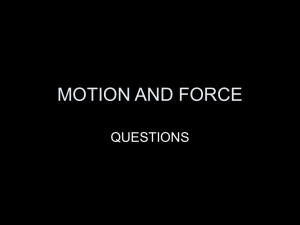TENNIS RULES
advertisement
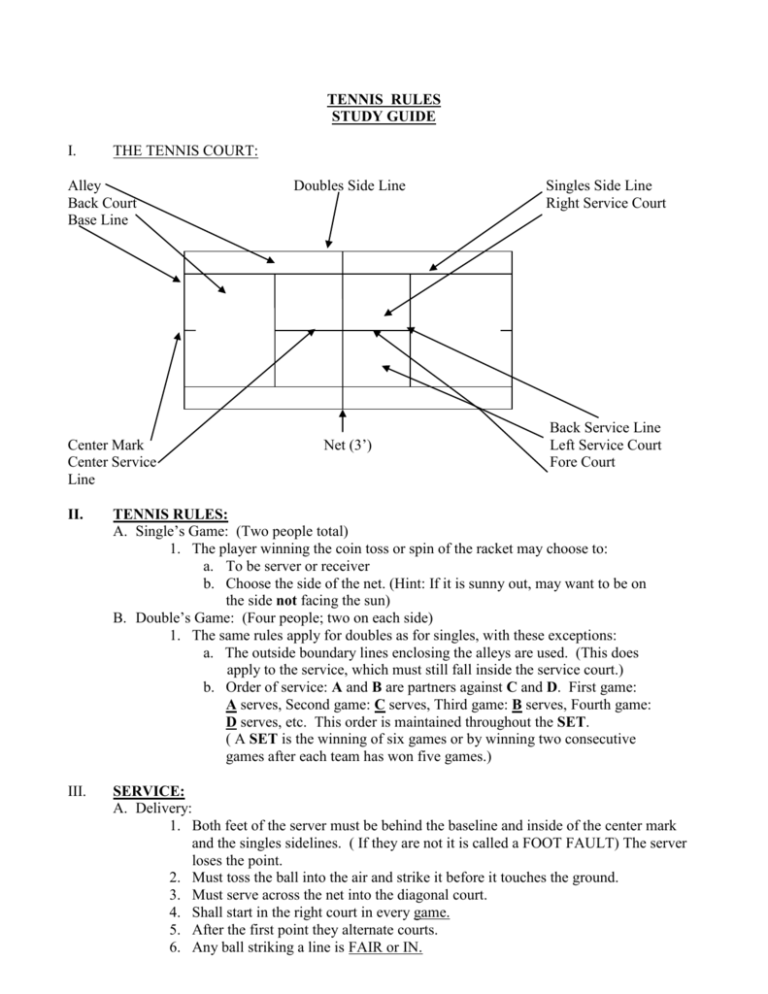
TENNIS RULES STUDY GUIDE I. THE TENNIS COURT: Alley Back Court Base Line Center Mark Center Service Line Doubles Side Line Net (3’) Singles Side Line Right Service Court Back Service Line Left Service Court Fore Court II. TENNIS RULES: A. Single’s Game: (Two people total) 1. The player winning the coin toss or spin of the racket may choose to: a. To be server or receiver b. Choose the side of the net. (Hint: If it is sunny out, may want to be on the side not facing the sun) B. Double’s Game: (Four people; two on each side) 1. The same rules apply for doubles as for singles, with these exceptions: a. The outside boundary lines enclosing the alleys are used. (This does apply to the service, which must still fall inside the service court.) b. Order of service: A and B are partners against C and D. First game: A serves, Second game: C serves, Third game: B serves, Fourth game: D serves, etc. This order is maintained throughout the SET. ( A SET is the winning of six games or by winning two consecutive games after each team has won five games.) III. SERVICE: A. Delivery: 1. Both feet of the server must be behind the baseline and inside of the center mark and the singles sidelines. ( If they are not it is called a FOOT FAULT) The server loses the point. 2. Must toss the ball into the air and strike it before it touches the ground. 3. Must serve across the net into the diagonal court. 4. Shall start in the right court in every game. 5. After the first point they alternate courts. 6. Any ball striking a line is FAIR or IN. IV. V. 7. Server has two (2) chances on each serve to get it in the correct court. (The first error or goof causes a FAULT. 8. May not serve until the receiver is ready. (Calling out the SCORE is a good way to say you are ready to serve and the server should always call their score first.) B. Faults: 1. Foot fault by steeping over the line. 2. The ball is sent anywhere outside the boundaries of the diagonally opposite service court or into the net. 3. The server misses the ball in attempting to strike it. 4. Two (2) faults in succession is called a DOUBLE FAULT and the server loses the point. C. Let: REPLAYS THE POINT 1. The ball tips the net and falls into the correct service court. 2. The ball is served when the receiver is not ready. 3. There is any outside interference during the serve or during the play following it. 4. Any play where there is a question of being legal. 5. When a LET is called during any circumstance- the ball is replayed. SCORING: A. Game: Love ……………….zero (nothing) 1st point…………….15 (fifteen) 2nd point……………30 (thirty) 3rd point……………40 (forty) 4th point……………Game…..provided one player or team is two (2) points ahead. B. Deuce: Tie = equal score 1. A score of 40-40 and any tie score thereafter is called DEUCE. 2. AD-IN: (Advantage Server) is the first point after deuce IF the server wins the point. 3. AD-OUT: (Advantage Receiver) is the first point after deuce IF the receiver wins the point. 5. EXPLANATION: A game may go back to deuce any number of times, but must continue until one player is ahead by two. EXAMPLE: a. Player A (server) has two points, Player B (receiver) has three points. SCORE = 30-40 b. A earns the next point. SCORE = 40-40 or DEUCE c. B earns the next point. SCORE = Advantage Receiver or AD-OUT d. A earns the next point. SCORE = DEUCE e. B earns the next TWO points. SCORE= Game, receiver. VI. CHANGING SIDES OF THE COURT: A. Players change sides of the net after every ODD NUMBER of games (Such as 1, 3, 5, 7, ect.) A SET: First team to win 6 games. VI. A MATCH: Next scoring unit after SET. Best 2 out of 3 sets. TENNIS TERMINOLOGY 1. Backhand: Stroke used to hit balls on the left side of a right handed player and on the right side of a left handed player. 2. Forehand: Stroke used to hit balls on the right side of a right handed player and on the left side of a left handed player. 3. Lob: A high arching shot that lands near the baseline. 4. Serve: The stroke used to put the ball into play at the beginning of each point. 5. Volley: The stroke used to hit the ball in the air before it has bounced. 6. Rally: Hit ball back and forth for long periods of time. EQUIPMENT: COURT, RACKET, AND AT LEAST TWO BALLS ETIQUETTE THOUGHT: Begin each point with two balls in server’s possession. Saves time and helps keep track of the faults on the serve. 1. HEAD: The part of the racket above the throat that includes the frame and the strings. 2. FACE: The hitting surface of the racket. Open face- racket turned so that hitting surface is facing upward. Closed face – racket turned so that the hitting surface is facing downward. Flat face – hitting surface of racket facing the net and perpendicular to the ground. 3. THROAT: The wooden or aluminum part of the frame, just below the racket head. 4. HANDLE: (Grip) The wooden shaft of the racket (or aluminum) which is covered with leather and gripped by the hand. 5. TRIM: Small stringing at the top and bottom of the racket Head for the purpose of holding the main strings in place.
